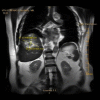Safe and Effective Use of Bilateral Erector Spinae Block in Patient Suffering from Post-Operative Coagulopathy Following Hepatectomy
- PMID: 32157075
- PMCID: PMC7081955
- DOI: 10.12659/AJCR.921123
Safe and Effective Use of Bilateral Erector Spinae Block in Patient Suffering from Post-Operative Coagulopathy Following Hepatectomy
Abstract
BACKGROUND Regional nerve blocks ideally provide safe and effective post-operative pain control, decrease opiate requirements, and enhance recovery from intense pain following major thoracic, abdominal, and musculoskeletal surgeries. The erector spinae plane block, a recently described novel treatment for chronic neuropathic pain and acute pain after thoracic surgery, can be performed with in plane infiltration and placement of a continuous infusion catheter deep to the erector spinae muscle at the tip of the transverse process, resulting in diffusion of local anesthetic between vertebrae and the paravertebral space with sensory blockade of spinal nerves as well as sympathetic branches. CASE REPORT We describe the novel use of the erector spinae block for primary pain control and uncomplicated catheter removal in the setting of anticoagulation following a major hepatectomy for intrahepatic cholangiocarcinoma. The use of the erector spinae block in this context provided effective post-operative analgesia. CONCLUSIONS Additional evidence from clinical trials will be helpful to evaluate the role of this relatively new block for peri-operative analgesia.
Conflict of interest statement
None.
Figures
References
-
- Grandhi MS, Kim AK, Ronnekleiv-Kelly SM, et al. Hepatocellular carcinoma: From diagnosis to treatment. Surg Oncol. 2016;25(2):74–85. - PubMed
-
- Khan AS, Dageforde LA. Cholangiocarcinoma. Surg Clin North Am. 2019;99(2):315–35. - PubMed
-
- Yoshino O, Perini MV, Christophi C, Weinberg L. Perioperative fluid management in major hepatic resection: An integrative review. Hepatobiliary Pancreat Dis Int. 2017;16(5):458–69. - PubMed
-
- Egger ME, Gottumukkala V, Wilks JA, et al. Anesthetic and operative considerations for laparoscopic liver resection. Surgery. 2017;161(5):1191–202. - PubMed
Publication types
MeSH terms
Substances
LinkOut - more resources
Full Text Sources
Medical


